Vyborg
| Vyborg (English) Выборг (Russian) Viipuri (Finnish) | |
|---|---|
| - Town[1] - | |
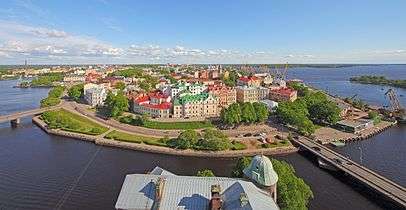 A view of Vyborg from the castle tower | |
.svg.png) Location of Leningrad Oblast in Russia | |
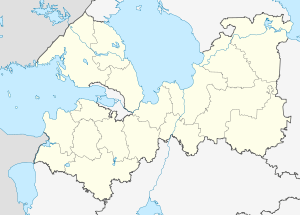 Vyborg | |
|
| |
 |
|
|
| |
| Administrative status (as of June 2013) | |
| Country | Russia |
| Federal subject | Leningrad Oblast[1] |
| Administrative district | Vyborgsky District[1] |
| Settlement municipal formation | Vyborgskoye Settlement Municipal Formation[1] |
| Administrative center of | Vyborgsky District,[1] Vyborgskoye Settlement Municipal Formation[1] |
| Municipal status (as of June 2013) | |
| Municipal district | Vyborgsky Municipal District[2] |
| Urban settlement | Vyborgskoye Urban Settlement[2] |
| Administrative center of | Vyborgsky Municipal District,[2] Vyborgskoye Urban Settlement[2] |
| Head[3] | Gennady Orlov[4] |
| Representative body | Council of Deputies[3] |
| Statistics | |
| Population (2010 Census) | 79,962 inhabitants[5] |
| - Rank in 2010 | 208th |
| Time zone | MSK (UTC+03:00)[6] |
| Founded | 11th or 12th century[7] |
| Previous names | Viipuri (until 1944) |
| Postal code(s)[8] | 188800–188802, 188804, 188805, 188807–188811, 188819, 188899 |
| Dialing code(s) | +7 81378[9] |
|
| |
| Vyborg on Wikimedia Commons | |
Vyborg (Russian Cyrillic: Выборг [ˈvɨbɔrk],[10] Finnish: Viipuri[11] [vi:puri], Swedish: Viborg [ˈviːborj], German: Wiborg [ˈviːboʁk], Estonian: Viiburi [ˈviːburi]) is a town and the administrative center of Vyborgsky District in Leningrad Oblast, Russia, located on the Karelian Isthmus near the head of the Vyborg Bay, 130 km (81 miles) to the northwest of St. Petersburg and 38 km (24 miles) south of Russia's border with Finland, where the Saimaa Canal enters the Gulf of Finland. Population: 79,962 (2010 Census);[5] 79,224 (2002 Census);[12] 80,924 (1989 Census).[13]
The town lies in the boundary zone between the East Slavic/Russian and Finnish worlds and has changed hands several times in history, most ultimately in 1944 when it was retaken by the Soviet Union from Finland during World War II.
The city hosts the Russian end of the 1,222 km (759 mi) Nord Stream gas pipeline, laid in 2011 and operated by a consortium led by Russia's Gazprom state hydrocarbons enterprise to pump 55 billion cubic meters (1.9 trillion cubic feet) of natural gas a year under the Baltic to Greifswald, Germany.[14]
History
![]() Sweden 1323-1710
Sweden 1323-1710
![]() Tsardom of Russia 1710–1721
Tsardom of Russia 1710–1721
![]() Russian Empire 1721–1811
Russian Empire 1721–1811
![]() Grand Duchy of Finland (Russian Empire) 1811-1917
Grand Duchy of Finland (Russian Empire) 1811-1917
![]() Finland 1917
Finland 1917
![]() Finnish Socialist Workers' Republic 1918
Finnish Socialist Workers' Republic 1918
![]() Finland 1918–1940
Finland 1918–1940
![]() Soviet Union 1940–1941
Soviet Union 1940–1941
![]() Finland 1941–1944
Finland 1941–1944
![]() Soviet Union 1944–1991
Soviet Union 1944–1991
![]() Russia 1991–present
Russia 1991–present
The area where Vyborg is located used to be a trading center on the Vuoksi River's western branch, which has dried up. The region was inhabited by the Karelians, a Balto-Finnic tribe which gradually came under the domination of Novgorod and Sweden. According to archeological digs and research, on the site of Vyborg there were a Karelian trading post in the 10th century.[15] Vyborg itself appeared in the 11th–12th centuries as a mixed Karelian-Russian settlement.[7]
The Viborg Castle was founded during the so-called "Third Swedish Crusade" in 1293 by marshal Torkel Knutsson[7] on the site of older Karelian fort which was burned.[16] The castle was fought over for decades between Sweden and the Novgorod Republic. By the Treaty of Nöteborg in 1323 between the Republic of Novgorod and Sweden, Vyborg was finally recognized as a part of Sweden. The town's trade privileges were chartered by the Pan-Scandinavian King Eric of Pomerania in 1403. It withstood a prolonged siege by Daniil Shchenya during the Russo–Swedish War of 1496–1497.
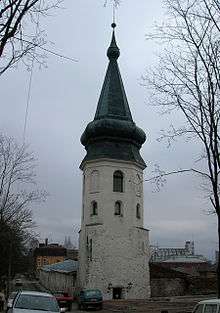
Under Swedish rule, Vyborg was closely associated with the noble family of Bååt, originally from Småland. The late-medieval commanders and fief holders of Vyborg were (almost always) descended from or married to the Bååt family. In practice, though not having this as their formal title, they functioned as Margraves, had feudal privileges, and kept all the crown's incomes from the fief to use for the defense of the realm's eastern border.
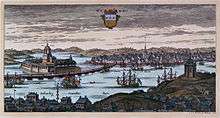
Vyborg remained in Swedish hands until its capture in 1710 after the Siege of Vyborg by Tsar Peter the Great in the Great Northern War.[7] In the course of Peter's second administrative reform, Vyborg became the seat of Vyborg Province of St. Petersburg Governorate.[17] The 1721 Treaty of Nystad, which concluded the war with Sweden, finalized the transfer of the town and a part of Old Finland to Russia.[7]
In 1744, Vyborg became the seat of Vyborg Governorate.[17] In 1783, the governorate was transformed into Vyborg Viceroyalty,[17] then in 1801 back into Vyborg Governorate. In 1802, Vyborg Governorate was renamed Finland Governorate.[17]
One of the largest naval battles in history, the Battle of Vyborg Bay, was fought off the shore of the Vyborg Bay on July 4, 1790.
After the rest of Finland was ceded to Russia in 1809, Emperor Alexander I incorporated the town and the governorate into the newly created Grand Duchy of Finland in 1811.[18]
In the course of the 19th century, the town developed as the center of administration and trade for the eastern part of Finland. The inauguration of the Saimaa Canal in 1856 benefited the local economy as it opened the vast waterways of Eastern Finland to the sea. Vyborg was never a major industrial center and lacked large production facilities, but due to its location it served as a focal point of transports of all industries on the Karelian Isthmus, Ladoga Karelia, and southeastern Finland.
Following the Russian Revolution of 1917 and the fall of the Russian Empire, Finland declared itself independent. During the Finnish Civil War, Vyborg was in the hands of the Finnish Red Guards until it was captured by the White Guard on the Battle of Vyborg, April 29, 1918. In April–May 1918, 360–420 civilians, mainly Russian men are murdered by White Guards during the Vyborg massacre.
In the inter-war decades, the town,Viipuri, was the second biggest town in Finland and the seat of Viipuri Province. In 1939, Vyborg had some 80,000 inhabitants, including sizable minorities of Swedes, Germans, Russians, Gypsies, Tatars, and Jews. During this time, Alvar Aalto built the Vyborg Library—a masterpiece of modern architecture.
During the Winter War between the Soviet Union and Finland in 1939–1940, over seventy thousand people were evacuated from Vyborg to western Finland. The Winter War was concluded by the Moscow Peace Treaty, which stipulated the transfer of Vyborg and the whole Karelian Isthmus—emptied of their residents—to Soviet control, where it was incorporated into the Karelo-Finnish Soviet Socialist Republic on March 31, 1940. As the town was still held by the Finns, the remaining Finnish population, some ten thousand people, had to be evacuated in haste before the handover. Thus, practically the whole population of Finnish Vyborg was resettled elsewhere in Finland. The town became the administrative center of Vyborgsky District.
The evacuees from Finnish Karelia came to be a vociferous political force and their wish to return to their homes was an important motive when Finland sought support from Nazi Germany against the Soviet threat. As a result, Finland and Nazi Germany fought on the same side in the Continuation War.
On August 29, 1941, Vyborg was captured by Finnish troops. At first, the Finnish Army did not allow civilians into the town. Of the 6,287 buildings, 3,807 had been destroyed. The first civilians started to arrive at the end of September and by the end of the year Vyborg had a population of about 9,700. In December 1941, the Government of Finland formally annexed the town along with the other areas lost in the Moscow Peace Treaty. However, this annexation was not recognized by any foreign state, not even Finlands co-belligerent, Germany. By 1942, it had risen to 16,000. About 70% of the evacuees from Finnish Karelia returned after the re-conquest to rebuild their looted homes, but were again evacuated after the Red Army's Vyborg–Petrozavodsk Offensive, timed to coincide with the Battle of Normandy. By the time of the Soviet offensive, the town had a population of nearly 28,000. The town was evacuated by June 19 and the defense of Vyborg was entrusted to the 20th Brigade. The town fell to the Red Army on June 20, 1944, but the Finns managed to halt the Soviet offensive at the Battle of Tali-Ihantala—the largest battle fought by any of the Nordic countries—in Viipuri rural municipality which surrounded the town. The town was seriously damaged.
In the subsequent Moscow Armistice of September 19, 1944, Finland returned to the borders set by the Moscow Peace Treaty and ceded more land than the treaty originally demanded. In the 1947 Paris Peace treaties, Finland relinquished all claims to Viipuri/Vyborg.
After the Winter War, Leningrad Oblast wanted to incorporate the area of Vyborg, but it took until November 1944 for it to be finally transferred from the Karelo-Finnish SSR.[18] During the Soviet era, the town was settled by people from all over the Soviet Union. The naval air bases of Pribilovo and Veshchevo were built nearby.
Administrative and municipal status
Within the framework of administrative divisions, Vyborg serves as the administrative center of Vyborgsky District.[1] As an administrative division, it is incorporated within Vyborgsky District as Vyborgskoye Settlement Municipal Formation.[1] As a municipal division, Vyborgoye Settlement Municipal Formation is incorporated within Vyborgy Municipal District as Vyborgoye Urban Settlement.[2]
Climate
Similar to many other areas along the Baltic Sea, Vyborg has a humid continental climate[19] with large temperature differences between summer and winter but too mild to be classified subarctic with five months above 10 °C (50 °F) in mean temperature. Winter temperatures are being somewhat moderated by maritime effects compared to Russian cities further inland even on more southerly latitudes, but still cold enough to be comparable to areas much further north that are nearer the Gulf Stream.
| Climate data for Vyborg | |||||||||||||
|---|---|---|---|---|---|---|---|---|---|---|---|---|---|
| Month | Jan | Feb | Mar | Apr | May | Jun | Jul | Aug | Sep | Oct | Nov | Dec | Year |
| Record high °C (°F) | 6.5 (43.7) |
10.0 (50) |
13.8 (56.8) |
22.1 (71.8) |
29.0 (84.2) |
32.9 (91.2) |
34.6 (94.3) |
33.4 (92.1) |
29.0 (84.2) |
19.0 (66.2) |
11.1 (52) |
8.4 (47.1) |
34.6 (94.3) |
| Average high °C (°F) | −4.0 (24.8) |
−4.1 (24.6) |
0.5 (32.9) |
7.2 (45) |
14.7 (58.5) |
19.2 (66.6) |
22.3 (72.1) |
20.2 (68.4) |
14.3 (57.7) |
7.9 (46.2) |
1.7 (35.1) |
−2.1 (28.2) |
8.2 (46.8) |
| Daily mean °C (°F) | −6.7 (19.9) |
−7.3 (18.9) |
−3.0 (26.6) |
3.0 (37.4) |
10.2 (50.4) |
15.0 (59) |
18.2 (64.8) |
16.3 (61.3) |
10.9 (51.6) |
5.5 (41.9) |
−0.4 (31.3) |
−4.5 (23.9) |
4.8 (40.6) |
| Average low °C (°F) | −9.5 (14.9) |
−10.5 (13.1) |
−6.4 (20.5) |
−0.5 (31.1) |
5.9 (42.6) |
11.1 (52) |
14.3 (57.7) |
12.7 (54.9) |
7.9 (46.2) |
3.2 (37.8) |
−2.3 (27.9) |
−7.1 (19.2) |
1.6 (34.9) |
| Record low °C (°F) | −36.8 (−34.2) |
−34.0 (−29.2) |
−29.0 (−20.2) |
−20.0 (−4) |
−5.0 (23) |
0.0 (32) |
5.8 (42.4) |
0.0 (32) |
−4.0 (24.8) |
−11.4 (11.5) |
−19.8 (−3.6) |
−34.0 (−29.2) |
−36.8 (−34.2) |
| Average precipitation mm (inches) | 48 (1.89) |
36 (1.42) |
40 (1.57) |
31 (1.22) |
40 (1.57) |
63 (2.48) |
65 (2.56) |
82 (3.23) |
68 (2.68) |
76 (2.99) |
67 (2.64) |
61 (2.4) |
677 (26.65) |
| Average rainy days | 6 | 5 | 7 | 10 | 14 | 15 | 15 | 15 | 17 | 17 | 13 | 9 | 143 |
| Average snowy days | 17 | 15 | 12 | 5 | 0 | 0 | 0 | 0 | 0 | 2 | 9 | 16 | 76 |
| Average relative humidity (%) | 87 | 85 | 82 | 74 | 68 | 71 | 73 | 77 | 82 | 86 | 88 | 89 | 80.2 |
| Source: Pogoda.ru.net[20] | |||||||||||||
Economy and culture
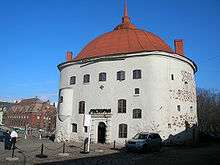
Vyborg continues to be an important industrial producer of paper. Tourism is increasingly important, and the Russian film festival Window to Europe takes place in the town each year.
An HVDC back-to-back facility for the exchange of electricity between the Russian and Finnish power grids was completed near Vyborg in 1982. It consists of three bipolar HVDC back-to-back schemes with an operating voltage of 85 kV and a maximum transmission rate of 355 MW, so that the entire maximum transmission rate amounts to 1,420 MW.
Sights
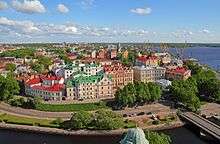
Vyborg's most prominent landmark is its Swedish-built castle, started in the 13th century and extensively reconstructed in 1891–1894. The Round Tower and the Rathaus Tower date from the mid-16th century and are parts of the Medieval Vyborg town wall. The Viipuri Library by Finnish architect Alvar Aalto and the Hermitage-Vyborg Center are a reference point in the history of modern architecture.
There are also Russian fortifications of Annenkrone, completed by 1740, as well as the monuments to Peter the Great (1910) and Torkel Knutsson. Tourists can also visit the house where the founder of the Soviet state Vladimir Lenin prepared the Bolshevik revolution during his stay in Viipuri from September 24 to October 7, 1917.
Sprawling along the heights adjacent to the Gulf of Finland is Mon Repos, one of the most spacious English landscape gardens in Eastern Europe. The garden was laid out on behest of its owner, Baron Ludwig Heinrich von Nikolay, at the turn of the 19th century. Most of its structures were designed by the architect Giuseppe Antonio Martinelli. Previously, the estate belonged to the future king Frederick I (Maria Fyodorovna's brother), who called it Charlottendahl in honor of his second wife.
Notable people
Bolshevik revolutionary Vladimir Lenin lived in the town for a period between the February Revolution and October Revolution of 1917. Finnish Nobel prize winner Martti Ahtisaari was born in Viipuri in 1937. Cyclist Viatcheslav Ekimov and Russia's first Formula One driver Vitaly Petrov were born in the town. Finnish soldier Lauri Törni, who received the Mannerheim Cross for his service during the Winter War, was born here, and later served in the Finnish, German, and United States armies. Lydia Sesemann, the first woman from Finland to obtain a doctoral degree, was also born in Vyborg.
Twin towns and sister cities
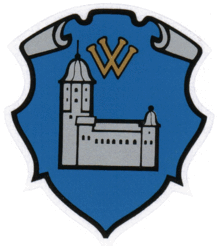
Vyborg is twinned with:
References
Notes
- 1 2 3 4 5 6 7 8 Oblast Law #32-oz
- 1 2 3 4 5 Law #17-oz
- 1 2 Charter of Vyborgskoye Urban Settlement, Article 1
- ↑ Official website of Vyborgskoye Urban Settlement. Head of the Municipal Formation, Gennady Vasilyevich Orlov (Russian)
- 1 2 Russian Federal State Statistics Service (2011). "Всероссийская перепись населения 2010 года. Том 1" [2010 All-Russian Population Census, vol. 1]. Всероссийская перепись населения 2010 года (2010 All-Russia Population Census) (in Russian). Federal State Statistics Service. Retrieved June 29, 2012.
- ↑ Правительство Российской Федерации. Федеральный закон №107-ФЗ от 3 июня 2011 г. «Об исчислении времени», в ред. Федерального закона №271-ФЗ от 03 июля 2016 г. «О внесении изменений в Федеральный закон "Об исчислении времени"». Вступил в силу по истечении шестидесяти дней после дня официального опубликования (6 августа 2011 г.). Опубликован: "Российская газета", №120, 6 июня 2011 г. (Government of the Russian Federation. Federal Law #107-FZ of June 31, 2011 On Calculating Time, as amended by the Federal Law #271-FZ of July 03, 2016 On Amending Federal Law "On Calculating Time". Effective as of after sixty days following the day of the official publication.).
- 1 2 3 4 5 Энциклопедия Города России. Moscow: Большая Российская Энциклопедия. 2003. p. 95. ISBN 5-7107-7399-9.
- ↑ Почта России. Информационно-вычислительный центр ОАСУ РПО. (Russian Post). Поиск объектов почтовой связи (Postal Objects Search) (Russian)
- ↑ Ленинградская область (in Russian). ruspostindex.ru. Retrieved March 20, 2014.
- ↑
- ↑ Wuorinen, John H. (1948), ed., Finland and World War II, 1939-1944, New York: Roland Press, p. 172.
- ↑ Russian Federal State Statistics Service (May 21, 2004). "Численность населения России, субъектов Российской Федерации в составе федеральных округов, районов, городских поселений, сельских населённых пунктов – районных центров и сельских населённых пунктов с населением 3 тысячи и более человек" [Population of Russia, Its Federal Districts, Federal Subjects, Districts, Urban Localities, Rural Localities—Administrative Centers, and Rural Localities with Population of Over 3,000] (XLS). Всероссийская перепись населения 2002 года [All-Russia Population Census of 2002] (in Russian). Retrieved August 9, 2014.
- ↑ Demoscope Weekly (1989). "Всесоюзная перепись населения 1989 г. Численность наличного населения союзных и автономных республик, автономных областей и округов, краёв, областей, районов, городских поселений и сёл-райцентров" [All Union Population Census of 1989: Present Population of Union and Autonomous Republics, Autonomous Oblasts and Okrugs, Krais, Oblasts, Districts, Urban Settlements, and Villages Serving as District Administrative Centers]. Всесоюзная перепись населения 1989 года [All-Union Population Census of 1989] (in Russian). Институт демографии Национального исследовательского университета: Высшая школа экономики [Institute of Demography at the National Research University: Higher School of Economics]. Retrieved August 9, 2014.
- ↑ The Pipeline, Nord Stream AG official website, Undated.Accessed: 14 June 2014.
- ↑ Jussi Katajala (2010). "Suomen kaupungit keskiajalla" (in Finnish). Retrieved 12 February 2016.
- ↑ Taavitsainen, Jussi-Pekka (1990). Ancient Hillforts of Finland. Suomen muinaismuistoyhdistyksen aikakausikirja 94. p. 240.
- 1 2 3 4 С. А. Тархов (2001). "Изменение административно-территориального деления России за последние 300 лет". Электронная версия журнала "География".
- 1 2 История Выборгского района, история Выборгской земли (in Russian). Муниципальное образование Выборгский район Ленинградской Области. Retrieved March 20, 2014.
- ↑ "Vyborg, Russia Climate Summary". Weatherbase. Retrieved 23 January 2015.
- ↑ "Climate in Vyborg". Pogoda i Klimat (in Russian). May 2011. Retrieved August 4, 2012.
Sources
- Совет депутатов муниципального образования "Выборгское городское поселение". Решение №63 от 1 июня 2010 г. «Устав муниципального образования "Город Выборг" Выборгского района Ленинградской области». (Council of Deputies of the Municipal Formation of "Vyborgskoye Urban Settlement". Decision #63 of June 1, 2010 Charter of the Municipal Formation of the "Town of Vyborg" of Vyborgsky District of Leningrad Oblast. ).
- Законодательное собрание Ленинградской области. Областной закон №32-оз от 15 июня 2010 г. «Об административно-территориальном устройстве Ленинградской области и порядке его изменения», в ред. Областного закона №23-оз от 8 мая 2014 г. «Об объединении муниципальных образований "Приморское городское поселение" Выборгского района Ленинградской области и "Глебычевское сельское поселение" Выборгского района Ленинградской области и о внесении изменений в отдельные Областные законы». Вступил в силу со дня официального опубликования. Опубликован: "Вести", №112, 23 июня 2010 г. (Legislative Assembly of Leningrad Oblast. Oblast Law #32-oz of June 15, 2010 On the Administrative-Territorial Structure of Leningrad Oblast and on the Procedures for Its Change, as amended by the Oblast Law #23-oz of May 8, 2014 On Merging the Municipal Formations of "Primorskoye Urban Settlement" in Vyborgsky District of Leningrad Oblast and "Glebychevskoye Rural Settlement" in Vyborgsky District of Leningrad Oblast and on Amending Various Oblast Laws. Effective as of the day of the official publication.).
- Законодательное собрание Ленинградской области. Областной закон №17-оз от 10 марта 2004 г. «Об установлении границ и наделении соответствующим статусом муниципальных образований Всеволожский район и Выборгский район и муниципальных образований в их составе», в ред. Областного закона №23-оз от 8 мая 2014 г. «Об объединении муниципальных образований "Приморское городское поселение" Выборгского района Ленинградской области и "Глебычевское сельское поселение" Выборгского района Ленинградской области и о внесении изменений в отдельные Областные законы». Вступил в силу со дня официального опубликования. Опубликован: "Вести", №27, 11 марта 2004 г. (Legislative Assembly of Leningrad Oblast. Oblast Law #17-oz of March 10, 2004 On Establishing the Borders of and Granting an Appropriate Status to the Municipal Formations of Vsevolozhsky District and Vyborgsky District and to the Municipal Formations Comprising It, as amended by the Oblast Law #23-oz of May 8, 2014 On Merging the Municipal Formations of "Primorskoye Urban Settlement" in Vyborgsky District of Leningrad Oblast and "Glebychevskoye Rural Settlement" in Vyborgsky District of Leningrad Oblast and on Amending Various Oblast Laws. Effective as of the day of the official publication.).
External links
| Wikivoyage has a travel guide for Vyborg. |

